wiper blades CHEVROLET OPTRA 5 2007 1.G Owners Manual
[x] Cancel search | Manufacturer: CHEVROLET, Model Year: 2007, Model line: OPTRA 5, Model: CHEVROLET OPTRA 5 2007 1.GPages: 422, PDF Size: 2.39 MB
Page 144 of 422
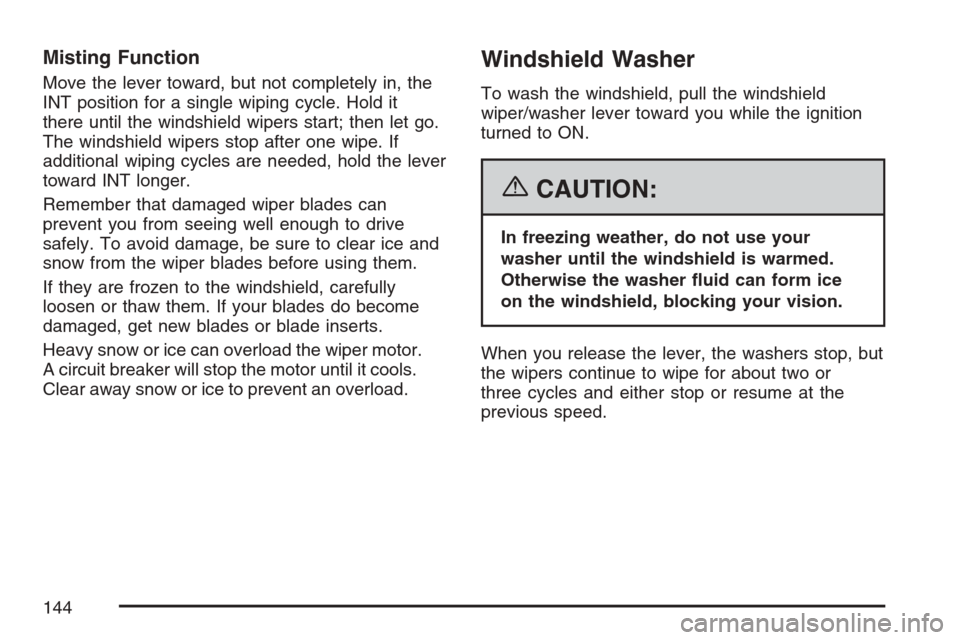
Misting Function
Move the lever toward, but not completely in, the
INT position for a single wiping cycle. Hold it
there until the windshield wipers start; then let go.
The windshield wipers stop after one wipe. If
additional wiping cycles are needed, hold the lever
toward INT longer.
Remember that damaged wiper blades can
prevent you from seeing well enough to drive
safely. To avoid damage, be sure to clear ice and
snow from the wiper blades before using them.
If they are frozen to the windshield, carefully
loosen or thaw them. If your blades do become
damaged, get new blades or blade inserts.
Heavy snow or ice can overload the wiper motor.
A circuit breaker will stop the motor until it cools.
Clear away snow or ice to prevent an overload.
Windshield Washer
To wash the windshield, pull the windshield
wiper/washer lever toward you while the ignition
turned to ON.
{CAUTION:
In freezing weather, do not use your
washer until the windshield is warmed.
Otherwise the washer �uid can form ice
on the windshield, blocking your vision.
When you release the lever, the washers stop, but
the wipers continue to wipe for about two or
three cycles and either stop or resume at the
previous speed.
144
Page 222 of 422
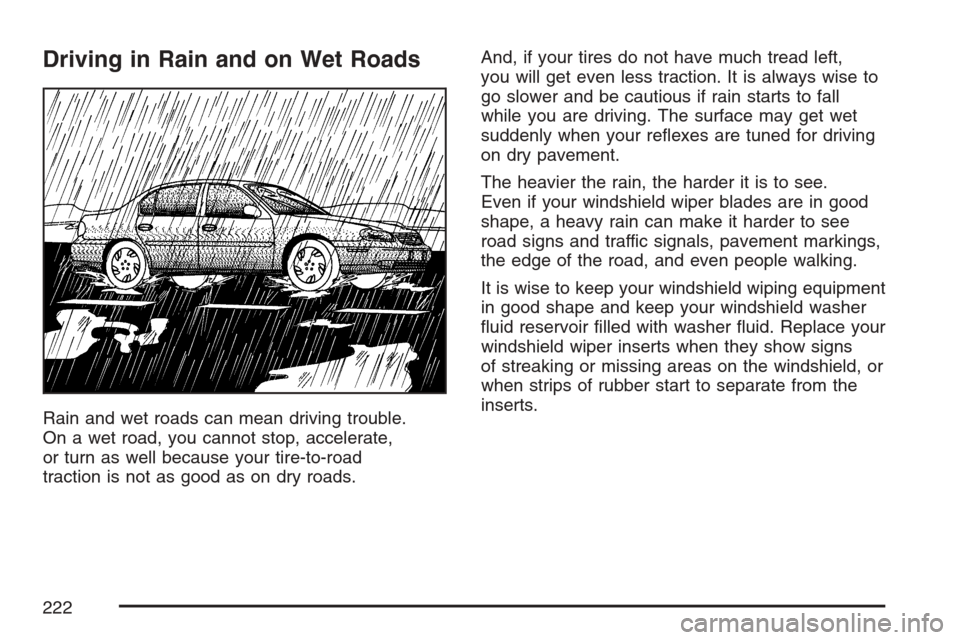
Driving in Rain and on Wet Roads
Rain and wet roads can mean driving trouble.
On a wet road, you cannot stop, accelerate,
or turn as well because your tire-to-road
traction is not as good as on dry roads.And, if your tires do not have much tread left,
you will get even less traction. It is always wise to
go slower and be cautious if rain starts to fall
while you are driving. The surface may get wet
suddenly when your reflexes are tuned for driving
on dry pavement.
The heavier the rain, the harder it is to see.
Even if your windshield wiper blades are in good
shape, a heavy rain can make it harder to see
road signs and traffic signals, pavement markings,
the edge of the road, and even people walking.
It is wise to keep your windshield wiping equipment
in good shape and keep your windshield washer
fluid reservoir filled with washer fluid. Replace your
windshield wiper inserts when they show signs
of streaking or missing areas on the windshield, or
when strips of rubber start to separate from the
inserts.
222
Page 228 of 422
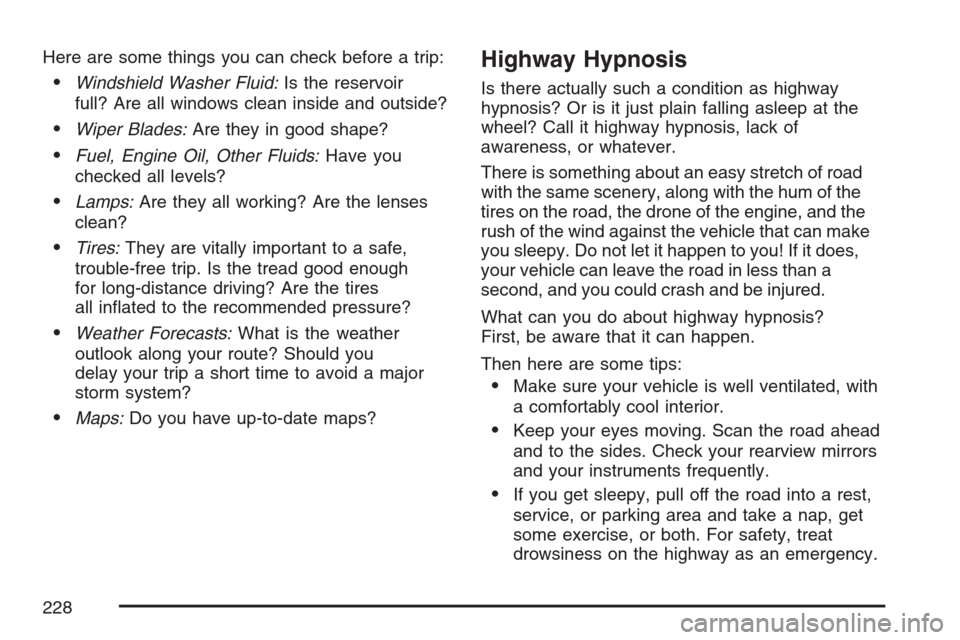
Here are some things you can check before a trip:
•Windshield Washer Fluid:Is the reservoir
full? Are all windows clean inside and outside?
•Wiper Blades:Are they in good shape?
•Fuel, Engine Oil, Other Fluids:Have you
checked all levels?
•Lamps:Are they all working? Are the lenses
clean?
•Tires:They are vitally important to a safe,
trouble-free trip. Is the tread good enough
for long-distance driving? Are the tires
all inflated to the recommended pressure?
•Weather Forecasts:What is the weather
outlook along your route? Should you
delay your trip a short time to avoid a major
storm system?
•Maps:Do you have up-to-date maps?
Highway Hypnosis
Is there actually such a condition as highway
hypnosis? Or is it just plain falling asleep at the
wheel? Call it highway hypnosis, lack of
awareness, or whatever.
There is something about an easy stretch of road
with the same scenery, along with the hum of the
tires on the road, the drone of the engine, and the
rush of the wind against the vehicle that can make
you sleepy. Do not let it happen to you! If it does,
your vehicle can leave the road in less than a
second, and you could crash and be injured.
What can you do about highway hypnosis?
First, be aware that it can happen.
Then here are some tips:
•Make sure your vehicle is well ventilated, with
a comfortably cool interior.
•Keep your eyes moving. Scan the road ahead
and to the sides. Check your rearview mirrors
and your instruments frequently.
•If you get sleepy, pull off the road into a rest,
service, or parking area and take a nap, get
some exercise, or both. For safety, treat
drowsiness on the highway as an emergency.
228
Page 247 of 422
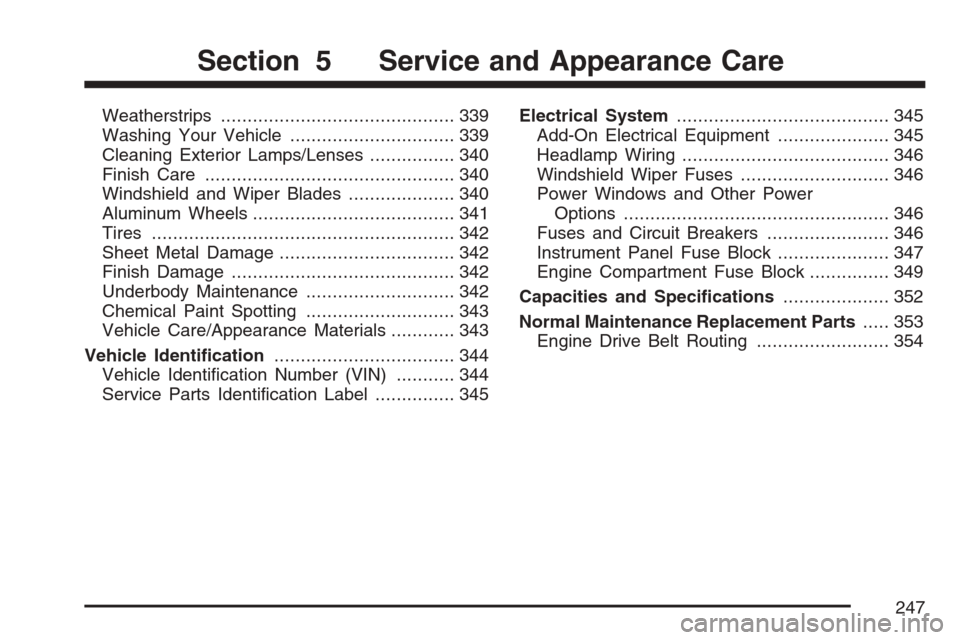
Weatherstrips............................................ 339
Washing Your Vehicle............................... 339
Cleaning Exterior Lamps/Lenses................ 340
Finish Care............................................... 340
Windshield and Wiper Blades.................... 340
Aluminum Wheels...................................... 341
Tires......................................................... 342
Sheet Metal Damage................................. 342
Finish Damage.......................................... 342
Underbody Maintenance............................ 342
Chemical Paint Spotting............................ 343
Vehicle Care/Appearance Materials............ 343
Vehicle Identi�cation.................................. 344
Vehicle Identification Number (VIN)........... 344
Service Parts Identification Label............... 345Electrical System........................................ 345
Add-On Electrical Equipment..................... 345
Headlamp Wiring....................................... 346
Windshield Wiper Fuses............................ 346
Power Windows and Other Power
Options.................................................. 346
Fuses and Circuit Breakers....................... 346
Instrument Panel Fuse Block..................... 347
Engine Compartment Fuse Block............... 349
Capacities and Speci�cations.................... 352
Normal Maintenance Replacement Parts..... 353
Engine Drive Belt Routing......................... 354
Section 5 Service and Appearance Care
247
Page 302 of 422
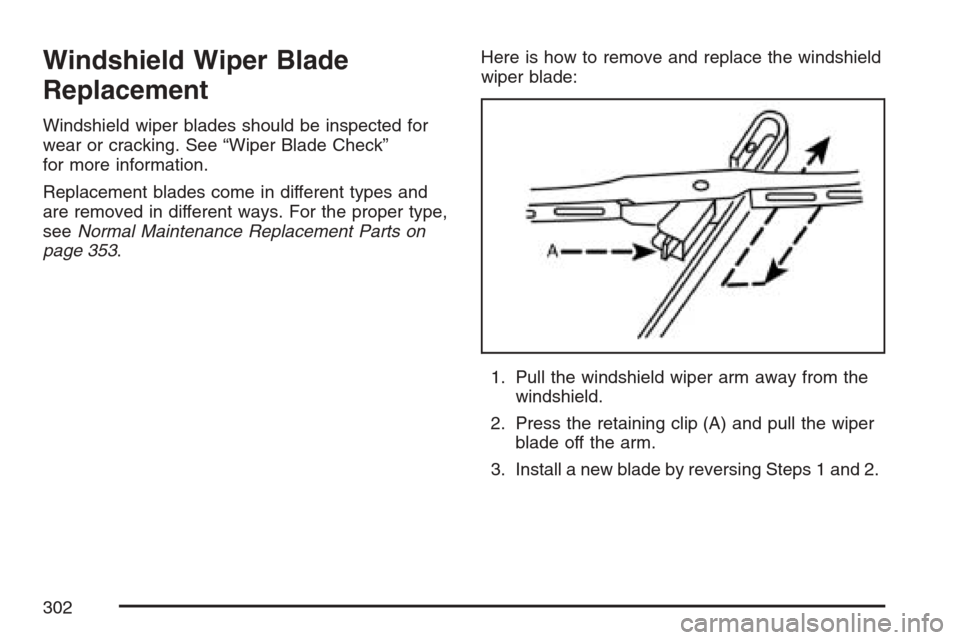
Windshield Wiper Blade
Replacement
Windshield wiper blades should be inspected for
wear or cracking. See “Wiper Blade Check”
for more information.
Replacement blades come in different types and
are removed in different ways. For the proper type,
seeNormal Maintenance Replacement Parts on
page 353.Here is how to remove and replace the windshield
wiper blade:
1. Pull the windshield wiper arm away from the
windshield.
2. Press the retaining clip (A) and pull the wiper
blade off the arm.
3. Install a new blade by reversing Steps 1 and 2.
302
Page 340 of 422
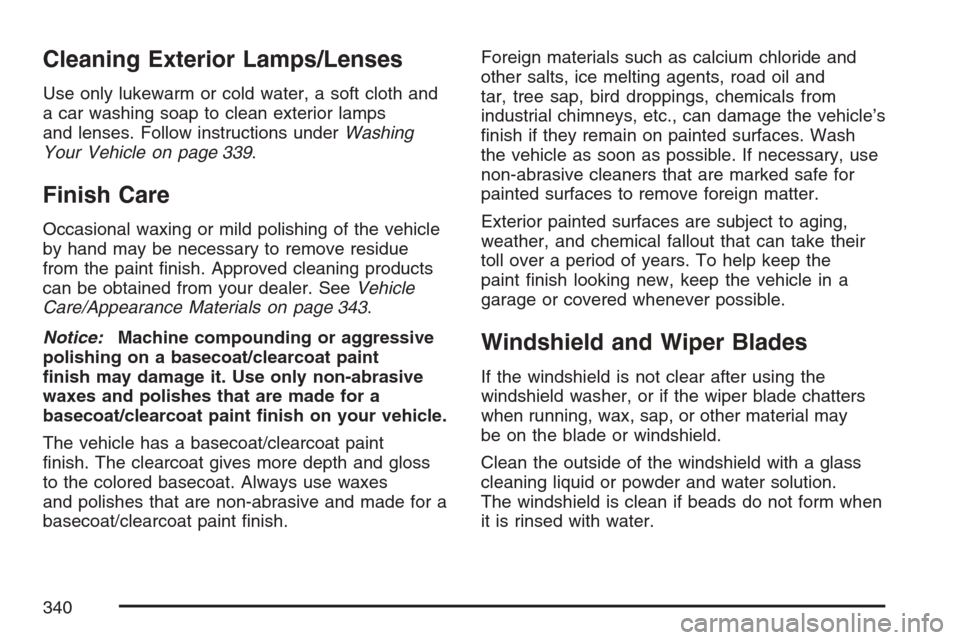
Cleaning Exterior Lamps/Lenses
Use only lukewarm or cold water, a soft cloth and
a car washing soap to clean exterior lamps
and lenses. Follow instructions underWashing
Your Vehicle on page 339.
Finish Care
Occasional waxing or mild polishing of the vehicle
by hand may be necessary to remove residue
from the paint finish. Approved cleaning products
can be obtained from your dealer. SeeVehicle
Care/Appearance Materials on page 343.
Notice:Machine compounding or aggressive
polishing on a basecoat/clearcoat paint
�nish may damage it. Use only non-abrasive
waxes and polishes that are made for a
basecoat/clearcoat paint �nish on your vehicle.
The vehicle has a basecoat/clearcoat paint
finish. The clearcoat gives more depth and gloss
to the colored basecoat. Always use waxes
and polishes that are non-abrasive and made for a
basecoat/clearcoat paint finish.Foreign materials such as calcium chloride and
other salts, ice melting agents, road oil and
tar, tree sap, bird droppings, chemicals from
industrial chimneys, etc., can damage the vehicle’s
finish if they remain on painted surfaces. Wash
the vehicle as soon as possible. If necessary, use
non-abrasive cleaners that are marked safe for
painted surfaces to remove foreign matter.
Exterior painted surfaces are subject to aging,
weather, and chemical fallout that can take their
toll over a period of years. To help keep the
paint finish looking new, keep the vehicle in a
garage or covered whenever possible.
Windshield and Wiper Blades
If the windshield is not clear after using the
windshield washer, or if the wiper blade chatters
when running, wax, sap, or other material may
be on the blade or windshield.
Clean the outside of the windshield with a glass
cleaning liquid or powder and water solution.
The windshield is clean if beads do not form when
it is rinsed with water.
340
Page 341 of 422
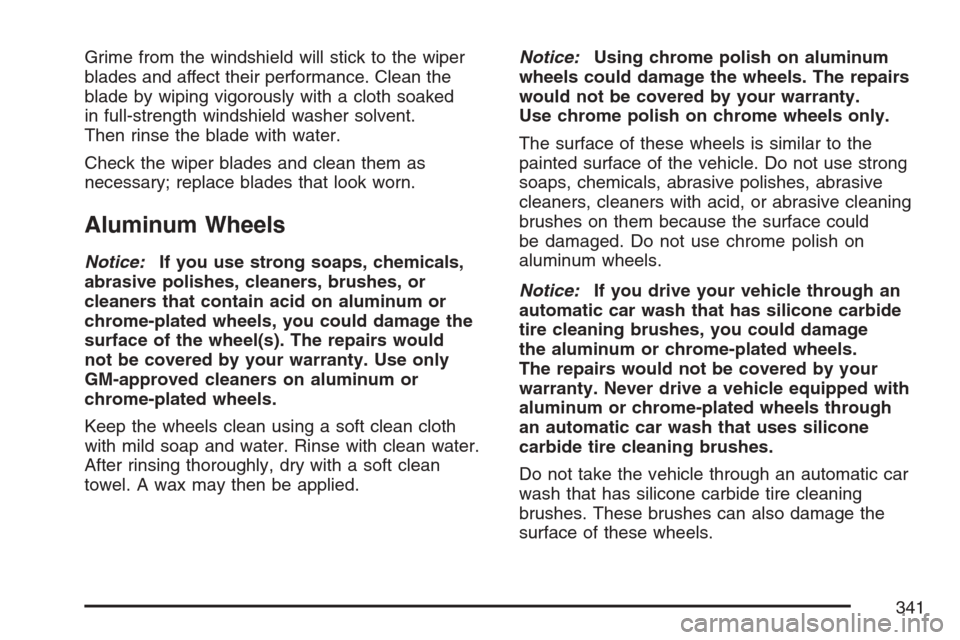
Grime from the windshield will stick to the wiper
blades and affect their performance. Clean the
blade by wiping vigorously with a cloth soaked
in full-strength windshield washer solvent.
Then rinse the blade with water.
Check the wiper blades and clean them as
necessary; replace blades that look worn.
Aluminum Wheels
Notice:If you use strong soaps, chemicals,
abrasive polishes, cleaners, brushes, or
cleaners that contain acid on aluminum or
chrome-plated wheels, you could damage the
surface of the wheel(s). The repairs would
not be covered by your warranty. Use only
GM-approved cleaners on aluminum or
chrome-plated wheels.
Keep the wheels clean using a soft clean cloth
with mild soap and water. Rinse with clean water.
After rinsing thoroughly, dry with a soft clean
towel. A wax may then be applied.Notice:Using chrome polish on aluminum
wheels could damage the wheels. The repairs
would not be covered by your warranty.
Use chrome polish on chrome wheels only.
The surface of these wheels is similar to the
painted surface of the vehicle. Do not use strong
soaps, chemicals, abrasive polishes, abrasive
cleaners, cleaners with acid, or abrasive cleaning
brushes on them because the surface could
be damaged. Do not use chrome polish on
aluminum wheels.
Notice:If you drive your vehicle through an
automatic car wash that has silicone carbide
tire cleaning brushes, you could damage
the aluminum or chrome-plated wheels.
The repairs would not be covered by your
warranty. Never drive a vehicle equipped with
aluminum or chrome-plated wheels through
an automatic car wash that uses silicone
carbide tire cleaning brushes.
Do not take the vehicle through an automatic car
wash that has silicone carbide tire cleaning
brushes. These brushes can also damage the
surface of these wheels.
341
Page 353 of 422
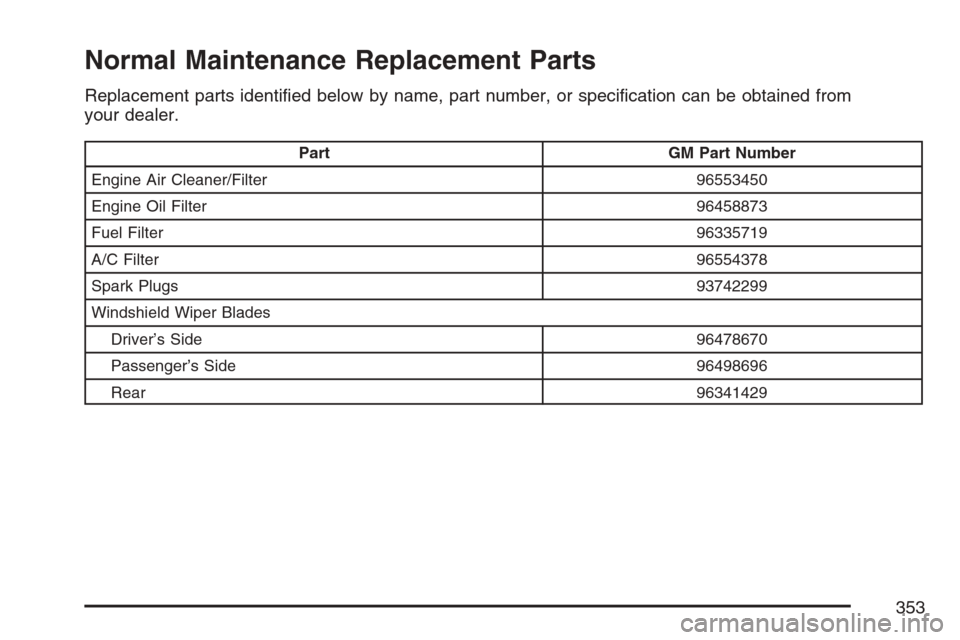
Normal Maintenance Replacement Parts
Replacement parts identified below by name, part number, or specification can be obtained from
your dealer.
Part GM Part Number
Engine Air Cleaner/Filter 96553450
Engine Oil Filter 96458873
Fuel Filter96335719
A/C Filter96554378
Spark Plugs93742299
Windshield Wiper Blades
Driver’s Side 96478670
Passenger’s Side 96498696
Rear96341429
353
Page 375 of 422
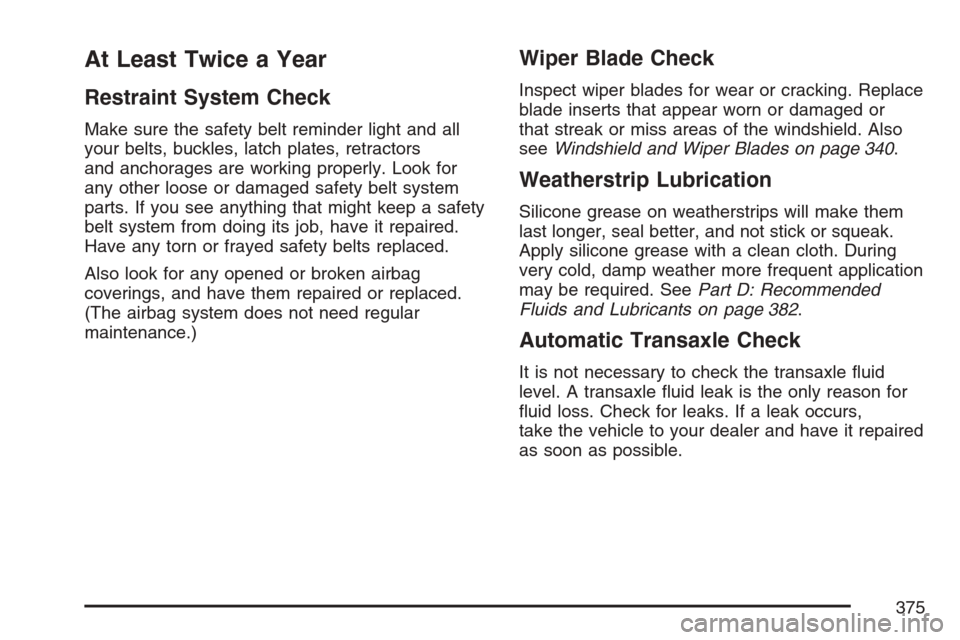
At Least Twice a Year
Restraint System Check
Make sure the safety belt reminder light and all
your belts, buckles, latch plates, retractors
and anchorages are working properly. Look for
any other loose or damaged safety belt system
parts. If you see anything that might keep a safety
belt system from doing its job, have it repaired.
Have any torn or frayed safety belts replaced.
Also look for any opened or broken airbag
coverings, and have them repaired or replaced.
(The airbag system does not need regular
maintenance.)
Wiper Blade Check
Inspect wiper blades for wear or cracking. Replace
blade inserts that appear worn or damaged or
that streak or miss areas of the windshield. Also
seeWindshield and Wiper Blades on page 340.
Weatherstrip Lubrication
Silicone grease on weatherstrips will make them
last longer, seal better, and not stick or squeak.
Apply silicone grease with a clean cloth. During
very cold, damp weather more frequent application
may be required. SeePart D: Recommended
Fluids and Lubricants on page 382.
Automatic Transaxle Check
It is not necessary to check the transaxle fluid
level. A transaxle fluid leak is the only reason for
fluid loss. Check for leaks. If a leak occurs,
take the vehicle to your dealer and have it repaired
as soon as possible.
375
Page 409 of 422
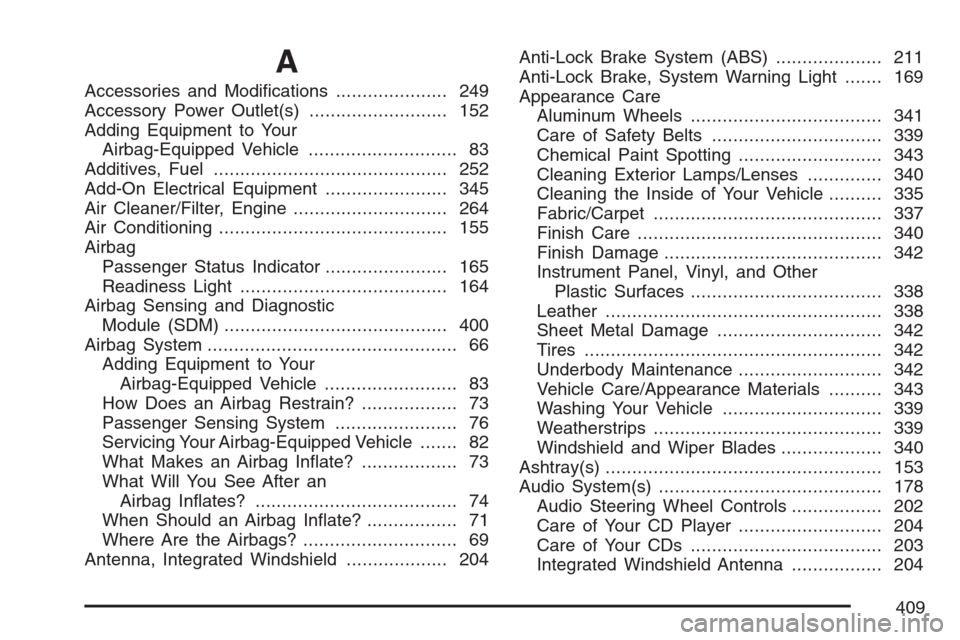
A
Accessories and Modifications..................... 249
Accessory Power Outlet(s).......................... 152
Adding Equipment to Your
Airbag-Equipped Vehicle............................ 83
Additives, Fuel............................................ 252
Add-On Electrical Equipment....................... 345
Air Cleaner/Filter, Engine............................. 264
Air Conditioning........................................... 155
Airbag
Passenger Status Indicator....................... 165
Readiness Light....................................... 164
Airbag Sensing and Diagnostic
Module (SDM).......................................... 400
Airbag System............................................... 66
Adding Equipment to Your
Airbag-Equipped Vehicle......................... 83
How Does an Airbag Restrain?.................. 73
Passenger Sensing System....................... 76
Servicing Your Airbag-Equipped Vehicle....... 82
What Makes an Airbag Inflate?.................. 73
What Will You See After an
Airbag Inflates?...................................... 74
When Should an Airbag Inflate?................. 71
Where Are the Airbags?............................. 69
Antenna, Integrated Windshield................... 204Anti-Lock Brake System (ABS).................... 211
Anti-Lock Brake, System Warning Light....... 169
Appearance Care
Aluminum Wheels.................................... 341
Care of Safety Belts................................ 339
Chemical Paint Spotting........................... 343
Cleaning Exterior Lamps/Lenses.............. 340
Cleaning the Inside of Your Vehicle.......... 335
Fabric/Carpet........................................... 337
Finish Care.............................................. 340
Finish Damage......................................... 342
Instrument Panel, Vinyl, and Other
Plastic Surfaces.................................... 338
Leather.................................................... 338
Sheet Metal Damage............................... 342
Tires........................................................ 342
Underbody Maintenance........................... 342
Vehicle Care/Appearance Materials.......... 343
Washing Your Vehicle .............................. 339
Weatherstrips........................................... 339
Windshield and Wiper Blades................... 340
Ashtray(s).................................................... 153
Audio System(s).......................................... 178
Audio Steering Wheel Controls................. 202
Care of Your CD Player........................... 204
Care of Your CDs.................................... 203
Integrated Windshield Antenna................. 204
409